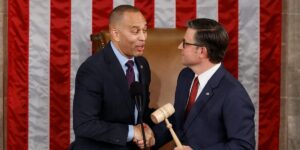The number of job openings on the last business day of August stood at 7.22 million, the US Bureau of Labor Statistics (BLS) reported in the Job Openings and Labor Turnover Survey (JOLTS) on Tuesday. This reading followed the 7.2 million openings reported for July and came in above the market expectation of 7.2 million.
“Over the month, both hires and total separations were little changed at 5.1 million,” the BLS noted in its press release. “Within separations, both quits (3.1 million) and layoffs and discharges (1.7 million) were little changed.”
Market reaction to JOLTS Job Openings data
This data failed to trigger a noticeable market reaction. At the time of press, the US Dollar Index was down 0.1% on the day at 97.85.
US Dollar Price This week
The table below shows the percentage change of US Dollar (USD) against listed major currencies this week. US Dollar was the weakest against the Japanese Yen.
| USD | EUR | GBP | JPY | CAD | AUD | NZD | CHF | |
|---|---|---|---|---|---|---|---|---|
| USD | -0.24% | -0.30% | -1.09% | -0.17% | -1.07% | -0.23% | -0.08% | |
| EUR | 0.24% | -0.08% | -1.02% | 0.06% | -0.83% | 0.00% | 0.15% | |
| GBP | 0.30% | 0.08% | -0.83% | 0.13% | -0.82% | 0.08% | 0.22% | |
| JPY | 1.09% | 1.02% | 0.83% | 0.97% | 0.07% | 0.76% | 1.08% | |
| CAD | 0.17% | -0.06% | -0.13% | -0.97% | -0.86% | -0.06% | 0.08% | |
| AUD | 1.07% | 0.83% | 0.82% | -0.07% | 0.86% | 0.85% | 0.99% | |
| NZD | 0.23% | -0.01% | -0.08% | -0.76% | 0.06% | -0.85% | 0.29% | |
| CHF | 0.08% | -0.15% | -0.22% | -1.08% | -0.08% | -0.99% | -0.29% |
The heat map shows percentage changes of major currencies against each other. The base currency is picked from the left column, while the quote currency is picked from the top row. For example, if you pick the US Dollar from the left column and move along the horizontal line to the Japanese Yen, the percentage change displayed in the box will represent USD (base)/JPY (quote).
This section below was published as a preview of the JOLTS Job Openings data at 08:00 GMT.
- The US JOLTS data will be watched closely ahead of the release of the September Nonfarm Payrolls report on Friday.
- Job Openings are forecast to edge slightly up to 7.2 million in August.
- The state of the labor market is a key factor for Fed officials when setting interest rates.
The Job Openings and Labor Turnover Survey (JOLTS) will be released on Tuesday by the United States (US) Bureau of Labor Statistics (BLS). The publication will provide data about the change in the number of Job Openings in August, alongside the number of layoffs and quits. Markets expect Job Openings in August to edge up slightly to 7.2 million compared to the previous month’s reading of 7.181 million.
JOLTS data is scrutinized by market participants and Federal Reserve (Fed) policymakers because it can provide valuable insights into the supply-demand dynamics in the labor market, a key factor impacting salaries and inflation. Job Openings have been declining steadily since reaching 12 million in March 2022, indicating a steady cooldown in labor market conditions. In January of this year, the number of Job Openings came in above 7.7 million before declining to 7.2 million by March. Since then, JOLTS Job Openings rose for two consecutive months, reaching 7.7 million in May. Nevertheless, summer months highlighted a further softening in labor, with openings sliding below 7.2 million in July.
What to expect in the next JOLTS report?
Job Openings are expected to edge higher to 7.2 million in August. Fed policymakers have been growing louder in pointing out their concerns over the labor market outlook.
Following the decision to lower the policy rate by 25 basis points at the September policy meeting, Fed Chair Jerome Powell acknowledged that job gains are running below the breakeven rate. On a more dovish note, Fed Governor Michelle Bowman argued that the recent downward revisions to employment data suggest that the Fed is even further behind the curve on interest rate cuts than previously estimated. Similarly, Kansas City Fed President Jeffrey Schmid explained that the September rate cut was appropriate to offset risks to the labor market but added that recent data point to rising risks.
The CME FedWatch Tool shows that markets nearly fully price in another 25 bps rate cut in October, while seeing about a 30% probability of a policy hold in December. A significant negative surprise in the JOLTS Job Openings data, with a reading well below 7 million, could feed into expectations for two more rate cuts and weigh on the US Dollar (USD) with the immediate reaction.
Conversely, a reading near or above the market consensus could help the USD stay resilient against its peers, at least until Friday’s Nonfarm Payrolls official employment report for September.
When will the JOLTS report be released and how could it affect EUR/USD?
Job Openings will be published on Tuesday at 14:00 GMT. Eren Sengezer, European Session Lead Analyst at FXStreet, shares his technical outlook for EUR/USD:
“The near-term technical outlook points to a lack of directional momentum. The Relative Strength Index (RSI) indicator on the daily chart stays close to 50 and the pair trades at around the 20-day and the 50-day Simple Moving Averages (SMAs).”
“On the downside, the 100-day SMA forms a critical support level at 1.1600 ahead of 1.1530 (Fibonacci 23.6% retracement of the February-September uptrend) and 1.1300 (Fibonacci 38.2% retracement). Looking north, resistance levels could be spotted at 1.1800 (round level), 1.1920 (September 17 high) and 1.2000 (static level, round level).”
(This story was updated on September 30 at 14:09 GMT to reflect a last-minute consensus change to 7.2 million from 7.1 million.)
Fed FAQs
Monetary policy in the US is shaped by the Federal Reserve (Fed). The Fed has two mandates: to achieve price stability and foster full employment. Its primary tool to achieve these goals is by adjusting interest rates. When prices are rising too quickly and inflation is above the Fed’s 2% target, it raises interest rates, increasing borrowing costs throughout the economy. This results in a stronger US Dollar (USD) as it makes the US a more attractive place for international investors to park their money. When inflation falls below 2% or the Unemployment Rate is too high, the Fed may lower interest rates to encourage borrowing, which weighs on the Greenback.
The Federal Reserve (Fed) holds eight policy meetings a year, where the Federal Open Market Committee (FOMC) assesses economic conditions and makes monetary policy decisions. The FOMC is attended by twelve Fed officials – the seven members of the Board of Governors, the president of the Federal Reserve Bank of New York, and four of the remaining eleven regional Reserve Bank presidents, who serve one-year terms on a rotating basis.
In extreme situations, the Federal Reserve may resort to a policy named Quantitative Easing (QE). QE is the process by which the Fed substantially increases the flow of credit in a stuck financial system. It is a non-standard policy measure used during crises or when inflation is extremely low. It was the Fed’s weapon of choice during the Great Financial Crisis in 2008. It involves the Fed printing more Dollars and using them to buy high grade bonds from financial institutions. QE usually weakens the US Dollar.
Quantitative tightening (QT) is the reverse process of QE, whereby the Federal Reserve stops buying bonds from financial institutions and does not reinvest the principal from the bonds it holds maturing, to purchase new bonds. It is usually positive for the value of the US Dollar.
Read the full article here















